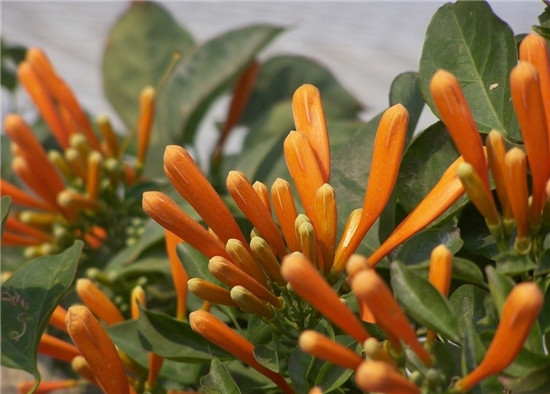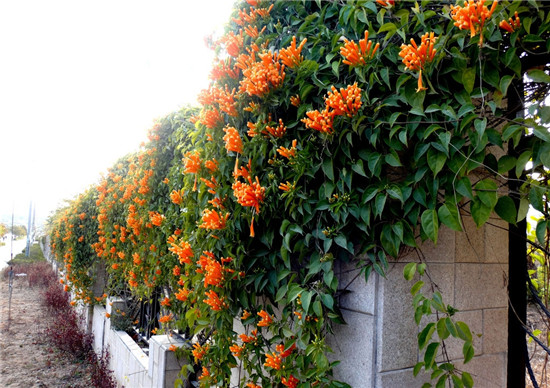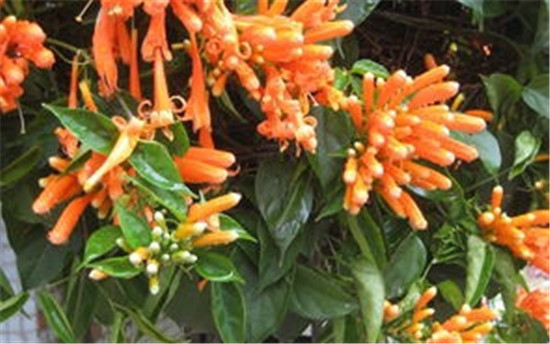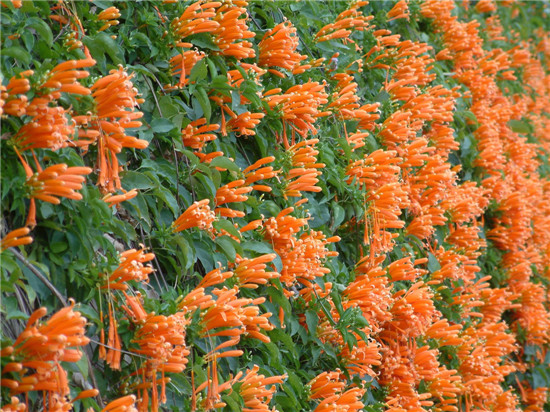Introduction of firecracker flowers
Firecracker flower is a kind of plant that can decorate the indoor space, which can be placed in flower sheds, open-air restaurants and courtyard doorways. Let's learn about this plant together.

Firecrackers flowers, mostly planted around the garden buildings, climbing on the Arbor, early summer red and orange flowers in clusters, shaped like firecrackers, so it is known as firecrackers. Like light, warm, humid climate and acidic soil. Sexual preference for the sunny environment and fertile, moist, acidic soil, growing rapidly, in South China, can keep the branches and leaves evergreen, can survive the winter in the open field. It can be used for covering the walls of low-rise buildings or for scaffolding, flower corridors, balconies and other vertical greening materials.
Firecracker flowers get their name because they are like firecrackers. Whenever spring blossoms, golden flowers are dotted on the green wall, like a string of firecrackers and a spark-like explosion, adding a lot of festive colors to the garden and environment.

Firecrackers are native to Central America and are commonly cultivated in warm areas around the world. Evergreen woody vines with linear, 3-lobed tendrils that can climb up to 7-8 meters. Leaflets 2-3, ovate to ovate-rectangular, 4-10 cm long, apex acuminate, stem broadly cuneate to rounded, petiole pilose. The flowers are orange-red, about 6 cm long. Calyx campanulate, glandular punctate. Corolla thick, inverted, with obvious white tomentose, many closely arranged into drooping panicles. Sexual preference for the sunny environment and fertile, moist, acidic soil, growing rapidly, in South China, can keep the branches and leaves evergreen, can survive the winter in the open field.
Firecrackers flower alias firecrackers, yellow eel vine, Mimeng flower, etc., because the flower is like firecrackers; Fujimoto, with 3-forked filamentous tendrils. Firecracker flower, alias: yellow eel vine, Liriodendron family, firecracker vine, with 3-forked filamentous tendrils. Leaves opposite; stamens inserted in middle of Corolla tube, filaments filiform, anthers diverging. Ovary cylindrical, densely pilose, style thin, stigma ligulate flattened, style and filaments protruding from Corolla tube. Fruit petal leathery, navicular, with many rows of seeds, seeds winged, thin membranous. It has a long florescence and is native to South America and Brazil. It has been widely cultivated as a garden ornamental rattan plant in tropical Asia. More planted around the garden buildings, climbing in the Arbor, early summer red and orange flowers in clusters, shaped like firecrackers, so it is known as firecrackers.

Firecracker flowers, vines, with 3-forked filamentous tendrils. Leaves opposite; leaflets 2-3, ovate, apex acuminate, base suborbicular, 4-10 cm long, 3-5 cm wide, upper and lower surfaces glabrous, with tiny scattered glandular cavities below, entire; leaf rachis ca. 2 cm long; petiolules 5-20 mm long.
Propagation method of firecracker flower
1. Striping planting: firecracker flowers can be planted by striping, which mainly uses the fallen vines to cut the skin and press the soil in the leaf axils, which can be carried out in spring, autumn and summer, which is suitable for summer. It can take root after 20-30 days, cut it into a new plant after a month and a half, and bloom in the same year. Plant more potted plants. Or directly press the strip in the container, do not move to the nursery to raise seedlings.

2. "planting": for cuttings cut by firecrackers, branches with strong growth and no diseases and insect pests should be selected, and the length should be about 10 meters. Each cuttings should have 3-4 nodes and 2 buds, and should be cut at 0.5 meters below the node to facilitate rooting. After insertion, press the base of the cuttings slightly with your fingers, so that the base of the cuttings is closely combined with the medium, and then pour enough water with a fine spray pot. After every 1-2 days, need to carry out a foliar spray to keep moist. After 3 weeks, if the stems and leaves do not atrophy, it still remains tender green, indicating that the incision has healed well and has taken root, and after about 10 days, it can be transplanted into the pot. The seedlings that have just come into the pot should be fully watered and kept in a semi-shady place for maintenance.
The above is the whole content of the introduction of firecrackers that I have summarized for you. I hope this article can help you. Please continue to follow us.
Related
- Wuhan Hospital Iron Tree Blooming Result Was Instantly Frightened by the Gardener Master
- Which variety of camellia is the most fragrant and best? Which one do you like best?
- What is the small blue coat, the breeding methods and matters needing attention of the succulent plant
- Dormancy time and maintenance management of succulent plants during dormancy
- Minas succulent how to raise, Minas succulent plant pictures
- What are the varieties of winter succulent plants
- How to raise succulent plants in twelve rolls? let's take a look at some experience of breeding twelve rolls.
- Attention should be paid to water control for succulent plants during dormant period (winter and summer)
- Watering experience of twelve rolls of succulent plants
- Techniques for fertilizing succulent plants. An article will let you know how to fertilize succulent plants.



